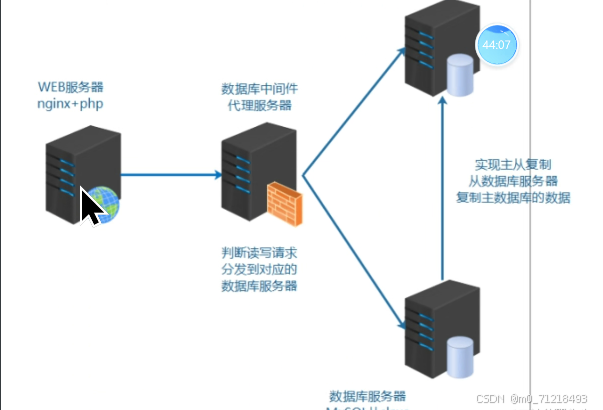一、python管理mysql
1、搭建主mysql
root@mysql57 \~\]# tar -xf mysql-5.7.44-linux-glibc2.12-x86_64.tar.gz \[root@mysql57 \~\]# cp -r mysql-5.7.44-linux-glibc2.12-x86_64 /usr/local/mysql \[root@mysql57 \~\]# rm -rf /etc/my.cnf \[root@mysql57 \~\]# mkdir /usr/local/mysql/mysql-files \[root@mysql57 \~\]# useradd -r -s /sbin/nologin mysql \[root@mysql57 \~\]# chown mysql:mysql /usr/local/mysql/mysql-files/ \[root@mysql57 \~\]# chown 750 /usr/local/mysql/mysql-files/ \[root@mysql57 \~\]# /usr/local/mysql/bin/mysqld --initialize --user=mysql --basedir=/usr/local/mysql \[root@mysql57 \~\]# ls /usr/local/mysql/ \[root@mysql57 \~\]# cp /usr/local/mysql/support-files/mysql.server /etc/init.d/mysql57 \[root@mysql57 \~\]# service mysql57 start \[root@mysql57 \~\]# /usr/local/mysql/bin/mysql -p Enter password: mysql\> alter user 'root'@'localhost' identified by 'root'; Query OK, 0 rows affected (0.00 sec) mysql\> create user 'blt'@'%' identified by 'blt'; Query OK, 0 rows affected (0.00 sec) mysql\> grant all on \*.\* to 'blt'@'%'; Query OK, 0 rows affected (0.00 sec) mysql\> flush privileges; Query OK, 0 rows affected (0.00 sec) mysql\> create database if not exists test charset utf8mb4; Query OK, 1 row affected (0.00 sec) mysql\> use test; Database changed mysql\> create table user(id int primary key auto_increment,username varchar(45) not null,password varchar(45) not null); Query OK, 0 rows affected (0.01 sec) mysql\> insert into user (username,password)values("aaa","aaa"); Query OK, 1 row affected (0.02 sec) mysql\> select \* from user; +----+----------+----------+ \| id \| username \| password \| +----+----------+----------+ \| 1 \| aaa \| aaa \| +----+----------+----------+ 1 row in set (0.00 sec) 2、pymysql \[root@client \~\]# python3 \>\>\> import pymysql \>\>\>conn=pymysql.connect(host="192.168.8.150",port=3306,database="test",user="blt",password="blt"); \>\>\> cursor=conn.cursor() 3、修改root权限 mysql\> update mysql.user set host='%' where user='root'; Query OK, 1 row affected (0.00 sec) Rows matched: 1 Changed: 1 Warnings: 0 mysql\> flush privileges; Query OK, 0 rows affected (0.00 sec) \>\>\>conn=pymysql.connect(host="192.168.8.150",port=3306,database="test",user="root",password="root"); \>\>\> curson=conn.cursor() \>\>\> cursor.execute("create user 'slave0'@'%' identified by 'slave0'") 0 \>\>\> cursor.execute("grant replication slave on \*.\* to 'slave0'@'%'") \>\>\> cursor.execute("flush privileges") \>\>\> cursor.execute("flush tables with read lock") 0 \>\>\> cursor.execute("unlock tables") 0 \>\>\> cursor.execute("flush tables with read lock") 0 \>\>\> cursor.execute("show master status") 0 \>\>\> print(cursor.fetchall()) () \>\>\> cursor.execute("show master status") 4、my.cnf \[root@mysql57 \~\]# rm -rf /etc/my.cnf \[root@mysql57 \~\]# vim /usr/local/mysql/my.cnf \[mysqld
basedir=/usr/local/mysql
datadir=/usr/local/mysql/data
socket=/tmp/mysql.sock
port=3306
log-error=/usr/local/mysql/data/db01-master.err
log-bin=/usr/local/mysql/data/binlog
server-id=10
character_set_server=utf8mb4
root@mysql57 \~\]# service mysql57 restart
\>\>\> conn=pymysql.connect(host="192.168.8.150",port=3306,database="test",user="blt",password="blt");
\>\>\> cursor=conn.cursor()
\>\>\> cursor.execute("show master status")
1
\>\>\> print(cursor.fetchall())
(('binlog.000001', 154, '', '', ''),)
\>\>\> cursor.execute("unlock tables")
0
5、slave数据库
\[root@slave57 \~\]# tar -xf mysql-5.7.44-linux-glibc2.12-x86_64.tar.gz
\[root@slave57 \~\]# cp -r mysql-5.7.44-linux-glibc2.12-x86_64 /usr/local/mysql
\[root@slave57 \~\]# ls /usr/local/mysql/
\[root@slave57 \~\]# mkdir /usr/local/mysql/mysql-files
\[root@slave57 \~\]# useradd -r -s /sbin/nologin mysql
\[root@slave57 \~\]# chown mysql:mysql /usr/local/mysql/mysql-files/
\[root@slave57 \~\]# chmod 750 /usr/local/mysql/mysql-files/
6、主从同步
\[root@mysql57 \~\]# rm -rf /usr/local/mysql/data/auto.cnf
\[root@mysql57 \~\]# yum -y install rsync
\[root@mysql57 \~\]# rsync -av /usr/local/mysql/data root@192.168.8.151:/usr/local/mysql/
\[root@slave57 \~\]# yum -y install rsync
\[root@slave57 \~\]# vim /usr/local/mysql/my.cnf
\[root@slave57 \~\]# cp /usr/local/mysql/support-files/mysql.server /etc/init.d/mysql57
\[root@slave57 \~\]# sed -i '$aexport PATH=$PATH:/usr/local/mysql/bin' /etc/profile
\[root@slave57 \~\]# sed -n '$p' /etc/profile
export PATH=$PATH:/usr/local/mysql/bin
\[root@slave57 \~\]# source /etc/profile
\[root@slave57 \~\]# chkconfig --add mysql57
\[root@slave57 \~\]# chkconfig mysql57
\[root@slave57 \~\]# chkconfig mysql57 on
7、错误
\[root@slave57 \~\]# service mysql57 start
Starting MySQL.2024-08-15T06:29:37.027747Z mysqld_safe error: log-error set to '/var/log/mariadb/mariadb.log', however file don't exists. Create writable for user 'mysql'.
ERROR! The server quit without updating PID file (/usr/local/mysql/data/slave57.pid).
\[root@slave57 \~\]# mkdir /var/log/mariadb
\[root@slave57 \~\]# touch /var/log/mariadb/mariadb.log
\[root@slave57 \~\]# chown -R mysql:mysql /var/log/mariadb/
\[root@slave57 \~\]# service mysql57 start
Starting MySQL. SUCCESS!
###### 二、MyCat实现读写分离

1、添加新的虚拟主机,关闭防火墙
\[root@mycat \~\]# systemctl stop firewalld
\[root@mycat \~\]# setenforce 0
2、上传jdk和Mycat
\[root@mycat \~\]# ls
3、解压并上传到指定位置
\[root@mycat \~\]# tar -xf Mycat-server-1.6.5-release-20180122220033-linux.tar.gz
\[root@mycat \~\]# tar -xf jdk-8u192-linux-x64.tar.gz
\[root@mycat \~\]# cp -r jdk1.8.0_192/ /usr/local/jdk
\[root@mycat \~\]# cp -r mycat/ /usr/local/
4、查看并且配置jdk文件
\[root@mycat \~\]# ls /usr/local/jdk/

\[root@mycat \~\]# sed -i '$aexport JAVA_HOME=/usr/local/jdk' /etc/profile
\[root@mycat \~\]# source /etc/profile
\[root@mycat \~\]# $JAVA_HOME
-bash: /usr/local/jdk: 是一个目录
\[root@mycat \~\]# sed -i '$aexport PATH=$PATH:$JAVA_HOME/bin' /etc/profile
\[root@mycat \~\]# source /etc/profile
\[root@mycat \~\]# $PATH
-bash: /usr/local/sbin:/usr/local/bin:/usr/sbin:/usr/bin:/root/bin:/usr/local/jdk:/usr/local/jdk/bin: 没有那个文件或目录
\[root@mycat \~\]# javac -version
javac 1.8.0_192
5、测试启动Mycat

\[root@mycat \~\]# /usr/local/mycat/bin/mycat console
6、配置读写分离
\[root@mycat logs\]# vim /usr/local/mycat/conf/server.xml
93 \